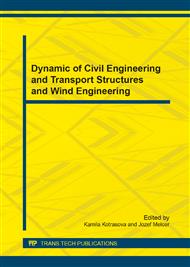p.257
p.263
p.269
p.275
p.280
p.285
p.291
p.296
p.302
Wind Tunnel Study of Vortex Shedding behind Cooling Tower Models
Abstract:
Wind tunnel measurements of vortex shedding behind cooling tower models were performed in VZLU. Two variants of cooling tower models were used, i.e. model with smooth wall outer surface and model with rough wall surface. Measurements were conducted using hot-wire anemometer. Time signal from the anemometer was transformed using Fast-Fourier routine into frequency spectrum. Measurements have shown significant differences between smooth and rough variant of model surface and dependency of vortex shedding frequency on Reynolds number.
Info:
Periodical:
Pages:
280-284
Citation:
Online since:
August 2014
Authors:
Price:
Сopyright:
© 2014 Trans Tech Publications Ltd. All Rights Reserved
Share:
Citation:


